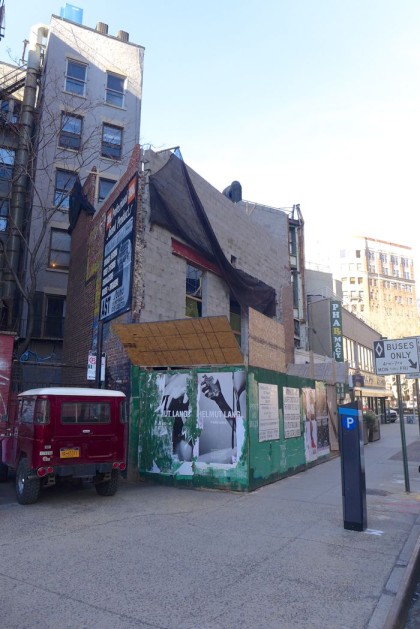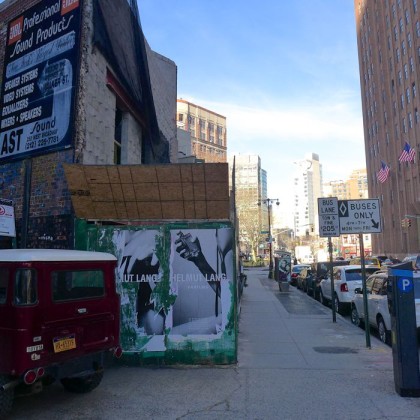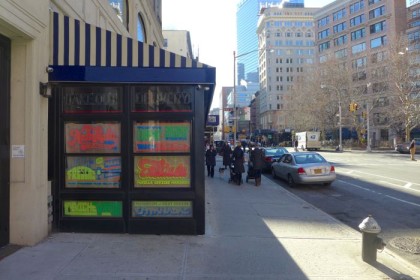Categories
Left column house ads
A Permanent Sidewalk Hog Just Got Approved Despite Community Objections
January 13, 2015 Construction, Restaurant/Bar News
 Back in November, Gregory Nardello asked Community Board 1 to approve an enclosed (i.e., permanent) sidewalk café, like the one at Super Linda, for his restaurant under construction at 11 Sixth Ave. From the Unofficial Minutes:
Back in November, Gregory Nardello asked Community Board 1 to approve an enclosed (i.e., permanent) sidewalk café, like the one at Super Linda, for his restaurant under construction at 11 Sixth Ave. From the Unofficial Minutes:
If I understood correctly, it would extend 10 feet into the sidewalk. The project’s architect, Shlomo [who goes by Steve] Wygoda, is a public member on the committee, so the committee members hesitated before deciding that it felt like a land grab and anyway they don’t like to approve sidewalk café licenses of any kind without the establishment being open for a year.
Blatantly ignoring the community’s objection, Nardello went to the city council for an approval. It was voted on this morning—and approved. So now we have an unfortunate precedent. What’s to stop other restaurants from deciding that they’d rather have more square footage to work with? And not just here, but all over the city? If the café at Super Linda is any indication, the one at 11 Sixth Ave. will be about the same size as the plywood structure currently hogging the sidewalk.
It’s possible that the structure will be attractive, but my hopes are not high.
 And here’s Super Linda’s café, for comparison’s sake.
And here’s Super Linda’s café, for comparison’s sake.
Update: Comments have been turned off due to spam. To have them turned back on, email tribecacitizen@gmail.com.
15 Comments
Subscribe
Subscribe to the TC Newsletter















Can someone break into Super Linda and pull down those hideous window clings?
I am assuming they have to pay rent to the city for the space? Where does that money go? Could it be funneled to that neighborhood to support parks or increased amenities in public areas to make up for the stolen- I mean rented- public sidewalk?
And what about sidewalk cafes- do they also pay a large amount for the privilege of taking over the sidewalks to increase their profit margins? Don’t get me wrong, I enjoy having a nice drink outside as much as the next person, but some streets are too clogged. For instance, navigating Greenwich from Jay to North Moore in the summer requires a lot of patience and fancy footwork to make it through the maze unscatheed.
So what’s the purpose of CB1? Can we just bypass them and go directly to the City Council?
This is only the Progressive thing to do. Since Community Boards are only half controlled by the Council Members, they need to go, or be bypassed. The Boro Prez who appoints half is so ‘boomer’, so old-ways. Although Boards are established with powers and responsibilities in the City Charter, we’ll set up own own unofficial alternatives: Participatory Budgeting Process and Discretionary Funding. Each promises small cash rewards for allegiance to the CM alone.
From the NYC dept of consumer affairs (DCA) sidewalk cafe license application packet available online:
“Sidewalk Café Applicant Fees […]
o Two-year License Fee: $510
o Fee for starting, renewing, or assigning DCA consent for all sidewalk café types: $445
o Consent Fees for sidewalk space to be paid each year. Please refer to the Consent Fees Charts (attached).
o Plan Review Fee for Unenclosed and Small Unenclosed Sidewalk Café Applicants: $310 […]
o City Planning Fee for Enclosed Sidewalk Café Applicants: $55 per seat with a $1,360 Minimum […]
2013 CONSENT FEES FOR STREET SPACE
For Unenclosed and Small Unenclosed Sidewalk Café
Zone 1: Manhattan – Southern tip to 96th Street
Minimum consent fee is $2,401.84 with $37.53 added for each additional square foot [in excess of 70 sq ft] […]
2013 CONSENT FEES FOR STREET SPACE
For Enclosed Sidewalk Café
Zone 1: Manhattan – Southern tip to 96th Street
Minimum consent fee is $4,803.68 with $37.53 added for each additional square foot [in excess of 70 sq ft]”
Got to be cheaper than in-your-face-storefront commercial rent and real property tax.
http://www.tribecatrib.com/content/tribeca-restaurateur-cries-foul-over-rejection-sidewalk-seating-0 [June 2012]
The Tribeca Committee’s policy regarding cafes on side streets goes back as far as current staff can remember, CB1 Community Liaison Andrew Brockman said, but the results have been inconsistent based on a variety of factors. Some sidewalk seating predates the policy, he said, and the Department of Consumer Affairs’ can approve an application regardless of the board’s recommendation.
The community board’s approval is one of several factors considered by the city. In most instances, the department favors approval, regardless of a negative vote by the community board, CB3 District Manager Susan Stetzer said.
“The Department of Consumer Affairs is going to approve it anyway,” said Stetzer, adding that her board was only able to secure a denial from the DCA in an instance where the operator had been causing problems in the neighborhood. “They absolutely won’t support any denials.”
What about the car parked on the sidewalk? Why is that allowed?
Isn’t Super Linda’s shed the one that the prior restaurant, Delphi, used for decades? That’s my memory of the space. if so, what’s the big deal about it?
The new shed is another story entirely.
Yes Delphi had that outdoor shed since the 1970’s. I believe that was grandfathered into Super Linda. Now will the outdoor table space in front of the now closed Josephine be granfathered in or can we enjoy sitting on our benches near where the tables were again in peace?
Extend the sidewalks? Or better yet, lets pedestrianize more streets.
1. The seizure of New York’s public sidewalk space for private profit purposes is enshrined in a modification to the zoning code. That modification (Section 14-4) was done by the staff in the City Planning office in the 1970’s without meaningful community input. The date of that section of the zoning code also predates Tribeca’s renaissance as a residential neighborhood. The content of it hands all of Tribeca over to sidewalk cafes without any local ability to challenge. Many other neighborhoods have the same problem, Soho excepted. The rules only subject a cafe owner to some minor technical issues about sidewalk width. A tiny saving grace is that if the sidewalk is inside a historic district, the LPC must also regulate any cafes. Alas, the sidewalk cafe in this article is not in any of Tribeca’s historic district (although it should be).
2. If Tribecans want greater control over their sidewalks, public spaces, and character of their neighborhood, they need to very noisy about demanding important and essential zoning changes. We urgently need a lot of changes anyway as the zoning code has obviously failed the broader neighborhood. We need height restrictions, greater definition for the word “contextuality”, and likely a conversion to “residential” status which would give our neighborhood a huge amount of protection from crazy visions that Big Real Estate has for us. I would add the sidewalk cafe issue onto the list of zoning changes that Tribeca very much needs.
3. Community Boards are treated by politicians as advisory extensions of government. They can only fight so much. The chair of another community board once told me cynically “they are shields for politicians.” The boards have no power, no real authority, and do not in a meaningful democratic sense represent the broad community, despite the many hardworking and well-intentioned volunteers who give of their time. My personal view (not that of Tribeca Trust) is that we need NY City Charter revision to first make community boards elected bodies, and subsequently to give them greater power over Land Use and the ULURP process, a suggestion zoning people rebel against – they consider citizens broadly speaking to just be “Nimby’s” rather than people who actually care about the places they live in.
4. This particular sidewalk cafe will further harm our case to get that area designated as part of Tribeca East Historic district. It is a kind of “death by a 1000 cuts to the historical character of that block, a death literally watched over by the LPC who knows very well our about request to include those blocks as a way to restore and maintain the sense of place there.
5. As a way forward, I should mention that Tribeca Trust has consulted some very well-known zoning consulting firms and we have a proposal on the table to study a rezoning for Tribeca with more widespread community input than is typical. It does require money and at present most of our resources are devoted to the problem of historic district expansion. Anyone feeling generous?
As a District Leader, Let me add to Lynn comments: The Tribeca Committee, of which I am a Public Member, is continuing to fight this currently legal land grab on two-fronts: We have asked for a meeting with Julie Menin, our new DCA commissioner ,to protest the wholesale approval of PERMANENT sidewalk cafes as the land grab it is; and we have formed a task force on the Community Board to find a way to create meaningful PERMANENT community imput in these sidewalk decisions . This task force hopes to include working with people like Lynn and our City Coucil Member Margaret Chin (who wanted tools to object but had none). Right now, Community Boards can stop a planned bar from getting a liquor license but we can’t prevent a real estate developer from grabbing a whole chunk of city sidewalk and build god’s knows what on it for a pittance and against the will of all who live nearby. And do it as long as builder pays his bills. That is wrong, wrong, wrong. Local Community must trump come and go commerce. Jean Grillo, District Leader, 66th AD, Part B
The CB 1 Task Force plans to go directly to City Planning with our issues and concerns as well as going to DCA. Indeed, it is City Planning that needs to rewrite its legislation as Lynn Ellsworth points out.
That said, let me also add, Community Board 1 is looking for new members as is Tribeca Trust. I am a member of both. So should all of those responding to the outrage of this land grab. People who sit on the board should put our community first, and be from the community. Sadly, someone who builds many of these sidewalk cafes currently sits on the very committee that has to vote on them. This too has to be addressed. JBG
Thank GOD!! A Task Force!!! Finally, something will continue to not get done! I would have gone with a Blue Ribbon Panel, but a Task Force is just as useless.
Thank you, Lynn, for confirming what we all thought – that “the boards have no power, no real authority, and do not in a meaningful democratic sense represent the broad community, despite the many hardworking and well-intentioned volunteers who give of their time.”
Erik, guess there’s no real need to follow the CB1 meetings except for comic relief.